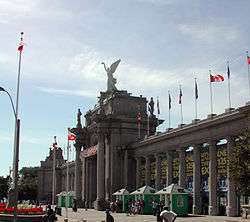Princes' Gates
| Princes' Gates | |
|---|---|
| Triumphal Arch | |
 Princes' Gates, 2003 | |
| Design: | Chapman and Oxley |
| Height: | 65 ft (20 m) |
| Length: | 300 ft (91 m) |
| Owner: | City of Toronto |
| Location: |
11 Princes' Boulevard, Exhibition Place |
 Princes' Gates Location of Princes' Gates in Toronto | |
| Coordinates: 43°38′5″N 79°24′34″W / 43.63472°N 79.40944°WCoordinates: 43°38′5″N 79°24′34″W / 43.63472°N 79.40944°W | |
The Princes' Gates is a triumphal arch monumental gateway at Exhibition Place in Toronto, Ontario, Canada. It was built to commemorate the 60th anniversary of Canadian confederation and was to be named The Diamond Jubilee of Confederation Gates. The structure's name was changed when it was learned that Edward, Prince of Wales and Prince George were travelling to Toronto. The princes cut the ribbon on the structure on August 30, 1927.[1]
Description
The gates are a 300-foot-long, 18-column structure with a 41-foot-high central arch, topped by the Goddess of Winged Victory statue, an interpretation of the original Winged Victory of Samothrace, designed by architect Alfred Chapman of Chapman and Oxley and carved by Charles McKechnie.[2] In her hand she holds a single maple leaf. There are nine pillars to either side of the main arch, representing the nine Canadian provinces in existence at the time of construction. Flanking the central arch are various figures representing progress, industry, agriculture, arts, and science.[1] The gates are made of a mix of stone and concrete, and the statue was poured concrete and weighed 12-tons.[1] Above the arch are the words "Canadian National Exhibition 1879 1927". The end of the gate features two water fountains and above the coat of arms of Ontario.
History
The Canadian National Exhibition (CNE) Exhibition Grounds, which was situated further to the west, was slowly growing eastward. Permanent buildings were being built further and further to the east, including the Coliseum, the Electrical and Engineering Building and the Automotive Building. The only gate to the exhibition was the Dufferin Gates at the west end of the grounds, although entry was possible by Strachan Avenue which turned west just south of the railway lines and continued west to the grounds. The CNE decided to build a new eastern gate to the grounds, a sixtieth anniversary of Canadian Confederation project.
The Princes' Gates were built in four months by the Sullivan and Fried Company of Toronto. The Princes' Gates were officially opened by Princes Edward, Prince of Wales (later Edward VIII), and George (later the Duke of Kent), on August 30, 1927, during that year's CNE. The gates were originally to be called The Diamond Jubilee of Confederation Gates. Just 25 days before, the CNE changed the name when it was learned that a tour of Canada by the Princes was taking place.[3] On the date of opening, the first to pass through the gate were 15,000 veterans in the annual Warriors' Day veterans' parade.[4]
At the same time, Strachan Avenue was extended south to meet Lake Shore Boulevard in front of the Gates.[5] Princes' Boulevard was built inside the grounds along an east-west axis starting at the Gates.
During 1986 and 1987, the Princes' Gates underwent a major restoration. In the fall of 1986, the Winged Victory statue was taken down and found to be seriously deteriorating. It was subsequently replaced by a glass-reinforced polymer plastic copy in 1987[6] to withstand the elements for over a century. That same year the gates officially became a listed building under the Ontario Heritage Act.
In 2006, the piazza around the base of the arch was renovated at the cost of CA$2 million. It added landscaped gardens, new paving stones, new sidewalk and bike lanes. It was a joint effort with Italian design firms of Milan, which is Toronto's twin city and where Toronto firms had worked previously on piazzas there.[7]
Gallery
| Wikimedia Commons has media related to Princes' Gates. |
 1927 plaque mounted on Princes' Gates central arch
1927 plaque mounted on Princes' Gates central arch Princes' Gates Plaque
Princes' Gates Plaque Gates decorated for the CNE
Gates decorated for the CNE The original architectural model of the Gates
The original architectural model of the Gates
References
- Filey, Mike (1992). Toronto Sketches. Dundurn Press. ISBN 1-55002-176-1.
- Notes
- 1 2 3 Filey 1992, p. 122.
- ↑ "Princes' Gates". CNE.
- ↑ "Ontario Heritage Trust: Princes' Gates".
- ↑ Filey, Mike (August 30, 2015). "Princes' Gates put new face on CNE". Toronto Sun.
- ↑ "Strachan Avenue and Milton/Georgetown Rail Corridor: Grade Separation Study" (PDF) (pdf). City of Toronto. Retrieved September 23, 2015.
- ↑ Filey 1992, p. 123.
- ↑ Lorinc, John. "Princes' Gates, Italian style". The Globe and Mail. Retrieved September 18, 2015.